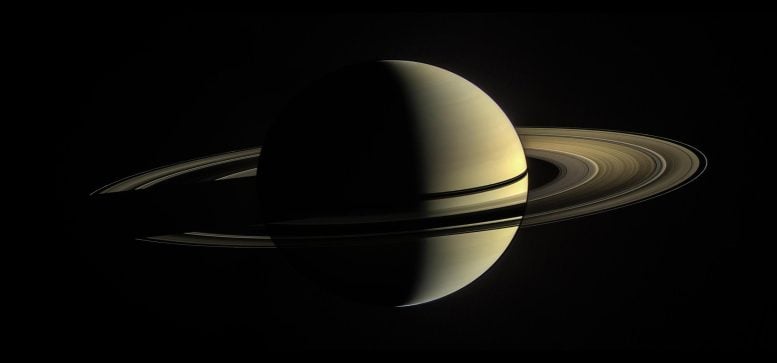
Esta fue una vista de Cassini desde la órbita alrededor de Saturno el 2 de enero de 2010. En esta imagen, los anillos en el lado nocturno del planeta han sido significativamente iluminados, revelando sus características más claramente. En el lado diurno, los anillos están iluminados por la luz solar directa y la luz reflejada en las cimas de las nubes de Saturno. Este paisaje de color natural es una composición de imágenes tomadas en luz visible con la cámara de ángulo estrecho de la nave espacial Cassini a una distancia de aproximadamente 1,4 millones de millas (2,3 millones de kilómetros) de Saturno. La nave espacial Cassini finalizó su misión el 15 de septiembre de 2017. Crédito: ASA/JPL-Caltech/Space Science Institute
Cassini mission data suggests that Saturn’s rings are young, possibly only a few hundred million years old, and could disappear in a similar timescale. The rings’ mass, purity, and debris accumulation rates indicate their relatively young age and short lifespan. Two studies show that the rings formed relatively recently and are rapidly losing mass, while a third predicts their disappearance within the next few hundred million years.
While no human could ever have seen Saturn without its rings, in the time of the dinosaurs, the planet may not yet have acquired its iconic accessories – and future Earth dwellers may again know a world without them.
Three recent studies by scientists at NASA’s Ames Research Center in California’s Silicon Valley examine data from NASA’s Cassini mission and provide evidence that Saturn’s rings are both young and ephemeral – in astronomical terms, of course.
The new research looks at the mass of the rings, their “purity,” how quickly incoming debris is added, and how that influences the way the rings change over time. Put those elements together, and one can get a better idea of how long they’ve been around and the time they’ve got left.

Although all four giant planets have ring systems, Saturn’s is by far the most massive and impressive. Scientists are trying to understand why by studying how the rings have formed and how they have evolved over time. Three recent studies by NASA researchers and their partners provide evidence that the rings are a relatively recent addition to Saturn and that they may last only another few hundred million years. Credit: NASA/JPL-Caltech/Space Science Institute
The rings are almost entirely pure ice. Less than a few percent of their mass is non-icy “pollution” coming from micrometeoroids, such as asteroid fragments smaller than a grain of sand. These constantly collide with the ring particles and contribute debris to the material circling the planet. The rings’ age has been hard to pin down, because scientists hadn’t yet quantified this bombardment in order to calculate how long it must have been going on.
Now, one of the three new studies[1] Da una mejor idea de la tasa total de llegada de material no glacial y, por lo tanto, hasta qué punto debe haber «contaminado» los anillos desde su formación. Esta investigación, dirigida por la Universidad de Colorado, Boulder, también indica que los micrometeoritos no llegan tan rápido como creen los científicos, lo que significa que la gravedad de Saturno podría atraer la materia de manera más efectiva hacia los anillos. Esta evidencia continúa diciendo que los anillos no pueden estar expuestos a esta granizada cósmica por más de unos pocos cientos de millones de años, una pequeña fracción de Saturno y los 4.600 millones de años del sistema solar.
Apoyando esta conclusión está el segundo artículo,[2] Dirigido por la Universidad de Indiana, que toma un ángulo diferente sobre el constante latido de los anillos por pequeñas rocas espaciales. Los autores del estudio identificaron dos cosas que se han descuidado en gran medida en la investigación. Específicamente, observaron la física que gobierna la evolución a largo plazo de los anillos y descubrieron que dos componentes importantes eran el bombardeo de micrometeoritos y la forma en que se distribuyen los desechos de esas colisiones dentro de los anillos. Teniendo en cuenta estos factores, se muestra que los anillos podrían haber alcanzado su masa actual en unos pocos cientos de millones de años. Los resultados también indican que debido a que son tan jóvenes, probablemente se formaron cuando las fuerzas gravitatorias inestables dentro del sistema de Saturno destruyeron algunas de sus lunas heladas.
«La idea de que los icónicos anillos principales de Saturno podrían ser una característica reciente de nuestro sistema solar ha sido controvertida», dijo Jeff Causey, investigador de Ames y coautor de uno de los artículos recientes. «Pero nuestros nuevos hallazgos complementan una trifecta de Medidas de Cassini que hacen que este descubrimiento sea difícil de evitar». Causey también se desempeñó como científico interdisciplinario en la misión Cassini a los anillos de Saturno.
Saturno, entonces, pudo haber pasado más de 4 mil millones de años antes de que adoptara su forma actual. Pero, ¿cuánto tiempo puedes contar con usar los hermosos anillos que conocemos hoy?
La misión Cassini descubrió que los anillos están perdiendo masa rápidamente a medida que cae material de las regiones más profundas del planeta. tercer papel[3] Además, dirigido por la Universidad de Indiana, determina por primera vez qué tan rápido se desplaza la materia anillada en esta dirección, y los meteoritos nuevamente juegan un papel. Sus colisiones con las partículas existentes del anillo y la forma en que los desechos resultantes son arrojados hacia afuera se combinan para formar una especie de cinta transportadora de movimiento que transporta el material del anillo hacia Saturno. Al calcular lo que significan todas esas partículas que fluyen para su eventual desaparición en el planeta, los investigadores han llegado a algunas noticias difíciles para Saturno: podría perder sus anillos en los próximos cientos de millones de años.
“Creo que estos resultados nos dicen que el bombardeo constante de todos estos desechos extraterrestres no solo contamina los anillos planetarios, sino que también debería debilitarlos con el tiempo”, dijo Paul Estrada, investigador de Ames y coautor de los tres estudios. «tal vez[{» attribute=»»>Uranus’ and Neptune’s diminutive and dark rings are the result of that process. Saturn’s rings being comparatively hefty and icy, then, is an indication of their youth.”
Young rings but – alas! – relatively short-lived, as well. Instead of mourning their ultimate demise, though, humans can feel grateful to be a species born at a time when Saturn was dressed to the nines, a planetary fashion icon for us to behold and study.
References:
“Micrometeoroid infall onto Saturn’s rings constrains their age to no more than a few hundred million years” by Sascha Kempf, Nicolas Altobelli, Jürgen Schmidt, Jeffrey N. Cuzzi, Paul R. Estrada and Ralf Srama, 12 May 2023, Science Advances.
DOI: 10.1126/sciadv.adf8537
“Constraints on the initial mass, age and lifetime of Saturn’s rings from viscous evolutions that include pollution and transport due to micrometeoroid bombardment” by Paul R. Estrada and Richard H. Durisen, 9 May 2023, Icarus.
DOI: 10.1016/j.icarus.2022.115296
“Large mass inflow rates in Saturn’s rings due to ballistic transport and mass loading” by Richard H. Durisen and Paul R. Estrada, 9 May 2023, Icarus.
DOI: 10.1016/j.icarus.2022.115221

«Alborotador. Amante de la cerveza. Total aficionado al alcohol. Sutilmente encantador adicto a los zombis. Ninja de twitter de toda la vida».







More Stories
El envejecimiento se produce en ataques repentinos, revelan los científicos
Evaluación de la dermatitis alérgica de contacto en pacientes remitidos para pruebas de parche.
Estudio: la actividad de las proteínas cancerosas aumenta el desarrollo del cáncer de próstata